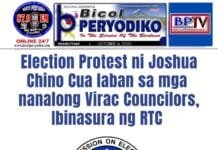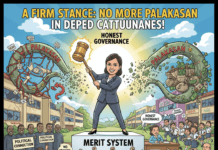(First of three parts)
It is true that Catanduanes was freed from centuries of darkness. No question about it. Thanks to the powers- that- was during the olden days who made it possible. They had that proactive, visionary attributes. They did not sleep on their job.
Thus, a glimmer of hope dawned upon us when light was created and provided with the establishment of the First Catanduanes Electric Cooperative (Ficelco) during the pre-Martiasl Law period.
With that light provided initially in the southern part particularly Virac, San Andres, and Bato, where the power distributor is based permanently, it eventually spread to the Renconada Area and the northern towns.
The late Cong. Jose M. Alberto crucially made it possible in the south, former Ambassador and Gov. Leandro I. Verceles Sr., extended it in the north when he was appointed governor by Pres. Corazon C. Aquino in the aftermath of the EDSA PEOPLE POWER REVOLUTION that toppled the Marcosian Dictatorship.
With that stroke of visionary leadership during the pre-Martial Rule Period, a glimmer of enlightenment, hope, and opportunities dawned upon the hapless inhabitants in this storm tossed, island province, known before as the Land of the Howling Winds.
However, within a span of 24 years back in 1995 energy supply provided by power-distributor Ficelco wasn’t enough, it was unstable and insufficient? The key players—Ficelco, NPC, and Suweco, wittingly or otherwise, bungled and failed on their respective role in the power industry.
Nevertheless, remedial measures to minimize, if not eradicate, brownouts is now being made by the key players. It must be realized soon.
This is the period in the history of our Happy Island where our newly elected congressional, provincial, municipal, and barangay leaders must do and emulate the Ala—Duterte Tenacity and Political Will attributes, sans his foul-mouthing etc.
The question, “Should we go solar? I posed in this column is, indeed, imperative and timely. And mind you, dear readers, the response could be in the declarative and interrogative modes: Yes! Why not?
Although I don’t have complete and updated data, reliable source said there are already households in Virac, San Andres and probably elsewhere using solar panel as their sources of electricity. The insufficient, unstable energy supply in our province, no thanks, to key players Ficelco, NPC, and Suweco drove them for good measure the use of solar panel as cost-saving, environment-friendly technology.
Anyway, under pain of sanction, these key players were given one month by PBM Edwin T. Tanael, chairman, Committee on Energy to submit a comprehensive plan or ways to solve these pestering brownouts hounding us for quite a long time.
The multi-sectoral consultative meeting of Ficelco stakeholders last July 12, 2019 called for by PBM Tanael, in aid of legislation, at the SP Bldg. Session Hall made it possible.
As of writing, however, only FICELCO and NPC submitted their respective plans. SUWECO have yet to submit theirs. Will they comply and beat the deadline? That we do not know. It remains to be seen. Let’s give the power company the benefit of the doubt.
Suffice it to say that the Catanduanes State University, my alma mater, is already solar panel-powered initially in the administration building.
Reliable source said that the Catanduanes Colleges, under the leadership of President & CEO EPHRAIM “TOY” GIANAN, went solar ahead than CSU several years ago.
According to PBM Tanael the Catanduanes Colleges had substantially reduced their current expenses from P80,000 to P30,000 in the last three years of solar panel-powered operation.
Kudoz then to the CSU administration led by Dr. Minerva I. Morales, SUC President III, and CC president and CEO Ephraim Gianan for using the solar panel technology as cost-saving, environment-friendly source of electricity in the academe. That’s walking the talking.
* * * *
Common sense dictates being practical and this is what guides Emiliano T. Legaspi Jr., president of iSecure Integrated Business Solution Inc., 14 years ago.
Sometime in 2005, in his visit to Hong Kong, Legaspi was encouraged to observe a trade exhibit featuring the latest technology in cost-saving device. His attention was diverted to three things, LED, or light-emitting diode products; solar products; and office automatic systems, in particular, the fingerprint biometric system.
Interestingly, the fingerprint biometric system are now in full use at the Catanduanes State University and both the executive and legislative offices at the Provincial Capitol.
Legaspi believes that introducing thee three products to the Philippines will help cut cost in electricity consumption and maintain transparency in government transactions. That’s because Legaspi, being an accountant who has served as a member of the Project Management Team of the Land Transportation Office, knows too well the tremendous expenses in electricity consumption. And of course, this is true of government agencies as well as private business, most especially now in our island province.
Dan Fabros of the Philippine Free Press (7/31/10) wrote: “When I got hold of one of the brochures saying ‘energy cost reduced by 75 percent in three years’ that had an impact on my ever-calculating mind. The brochure shows that that carbon emission (is) reduced by 90 percent each year, meaning the products are environment-friendly, and the more I became interested,”Legaspi said.
That brochure led Legaspi to knocking at the door of Delight Tehchnology Co. Ltd., a company under the Delight Group founded in 1979. Legaspi decided to bring Deight’s technology to the Philippines, LED lighting, renewable energy products and the latest “green,” that is, environment-friendly technology.
He enumerates the benefits derived from using Delight’s LED lighting energy-saving which means (1) no heat loss and saves up to 90 percent of electricity and thus reduce energy cost; (2) long life span of 15,000 working hours, thus reducing maintenance costs; (3) environment-friendly technology, that is, no mercury, lead and other harmful substances with less disposal waste in its long life span; (4) high durability as there’s no glass filament content;
(5) low operating temperatures, as the operating temperature is 40 to 50 percent lower than traditional lighting which thus reducing cooling costs; (6) intelligent lighting as LED’s provide pure saturated colors of up to 130 percent more color gamut; and (7) converting sunlights to electricity using photovoltaic, concentrating solar power and various experimental technologies.























